'Running in the Dark' in Bremen
Just found out that the Bremen gamelan group Gamelan Kancil are playing Running in the Dark on Nov 27, working from the score they found here. Hope they make a recording, be curious to see what they make of it…
Just found out that the Bremen gamelan group Gamelan Kancil are playing Running in the Dark on Nov 27, working from the score they found here. Hope they make a recording, be curious to see what they make of it…
I've just got a new toy (tx John!). It's a Cheetah MQ8 midi sequencer. This is UK made, apparently released sometime in the late 80s as a competitor to the Alesis MMT-8. I've only just started to figure it out: pretty crazy trying to do everything with a combination of button presses and a tiny, dim LCD screen!
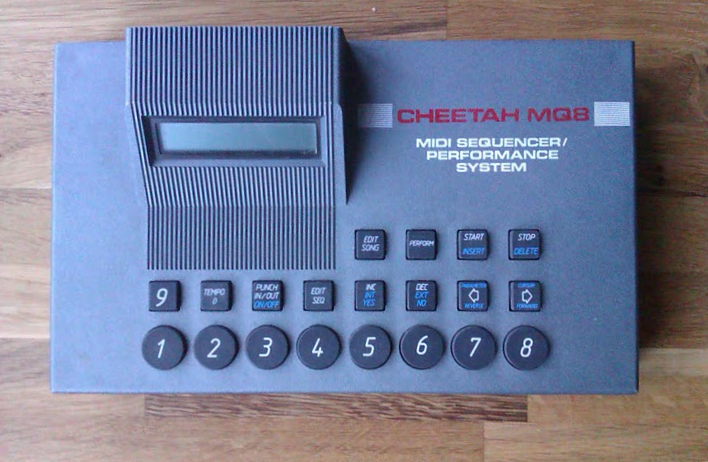
Don't listen to this one at all unless you like really hardcore distortion. No, scrub that, just don't listen to this one. Please. (Brownian walks in SuperCollider, samples & fx in Logic Pro.)
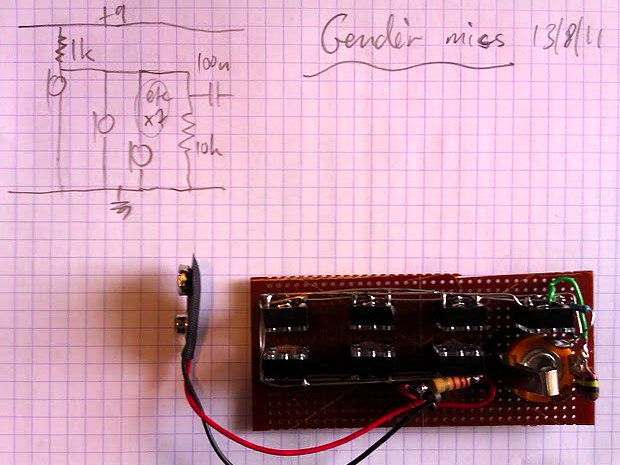
The gendèr miking strategy just got simpler again. After some experimentation, it turned out I was getting better results by just whacking all seven mikes in parallel and 'mixing' them with a single 10k resistor. Loads of cross talk, but for this setup it doesn't really matter. The virtual-earth op-amp design wasn't working out, trying to make it run from a single 9v battery was giving me headaches. This is sounding pretty good, perhaps a bit too much percussive thump at the start of the note: need to find a different way of mounting the mikes, at the moment they are just blu-tacked to the casing.
Not sure if this is really going anywhere really, but… a little bit of gendèr and ketipung impro sliced up in SuperCollider:
'trip points one-shot cap' is (yet another) piece inspired by ripped off from alluding to Louis Andriessen's gritty post-minimalist classic 'Hoketus'.
There are two main building blocks. The first is… I was rummaging around in my box of old electronics, and found an optical theremin I'd built years ago. The IC at the heart of this is a bit of a classic, a Texas Instruments SN76477, a very early chip designed to make sounds for toys and games, also great for musical experimentation.
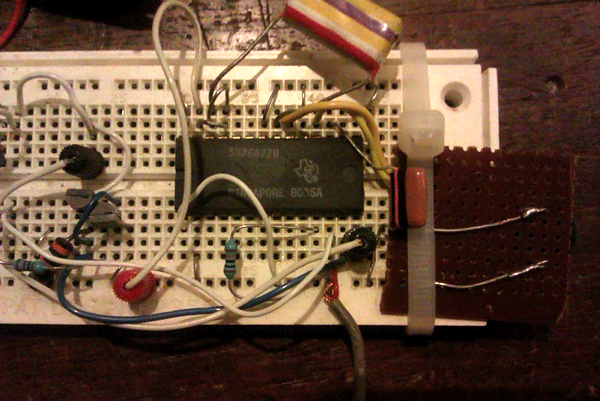
The second part of the track is itself made up of two layers. At the bottom is a two-second slice (ntfot82.aif) of an improvisation made with… well, to tell the truth, I can't remember! An out-of-tune guitar played with a chopstick, I think, but I'm not sure what I was processing it through, might have been hardware, might have been software. This short file was then sliced up and remixed in SuperCollider (code below).
The final track was composed in Logic 9: no added effects there apart from a bit of fake stereo.
//SuperCollider code
s.boot;
p = “/Users/jsimon/Music/tedsound/prosim/nolap_firstofthese/slices/ntfot82.aif”;
b = Buffer.read(s, p);
b = Buffer.read(s, p, bufnum: 0);
b.play; //quick check
b.free; // eventually
(
SynthDef(\mybuf, { |out, bufnum, sig, rate=1, slices=16, slice=16|
var myenv, env, start, len;
len = BufFrames.kr(bufnum);
start = (len / slices * slice);
myenv = Env.linen(0.01, 0.2, 0.1); //attack, sustain, release
sig = PlayBuf.ar(2, bufnum, BufRateScale.kr(bufnum) * rate, startPos: start, loop: 1);
env = EnvGen.kr(myenv, Impulse.kr(0), doneAction: 2);
Out.ar(out, sig * env)
}).add;
)
(
a = Pbind(
\instrument, \mybuf,
\slice, Prand((1 .. 16), inf)
);
)
a.play;
(
b = Pbind(
\instrument, \mybuf,
\slice, Pseq((1 .. 16).scramble, inf)
);
)
b.play;
(
c = Pbind(
\instrument, \mybuf,
\slice, Pseq((1 .. 16).pyramid, inf)
);
)
c.play;
// this is medium fab
// need to get \freq or something in the synth also
// also figger out how buffer number allocation works
// could allocate several buffers and switch between?!?
TempoClock.default.tempo = 160/60;
(
d = Pbind(
\instrument, \mybuf,
\slice, Pseq((1 .. 16).pyramid(9), 1),
// careful pyramid returns all kinds of different length arrays
// 136, 256, 271 seems to be the three possibilities
// (1 .. 16).pyramid(9).size; -> 256
\dur, 0.5
);
)
d.play;
Still at the point of being a tech demo, but my latest text-to-screech project has moved forward a little. Here you can see speech sounds controlled by Max 5 piped into PureData. In Pd, I'm using some old tricks with the 'freeze' function in freeverb plus some pitch shifting to further play with the sound. As a potentially interesting wrinkle, the effects in Pd are turned on and off by the words typed in Max: 'reverb', 'freeze' etc.
Hmm. Where to go next?
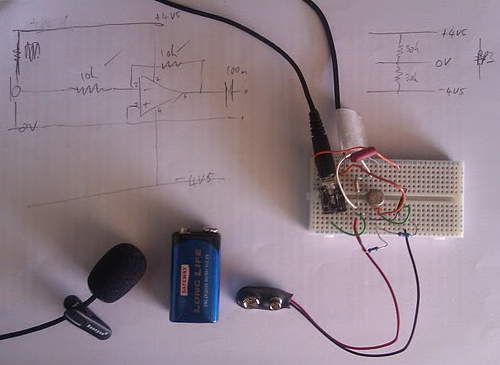
Up to something a bit different today: electronics! Yum. I'm building a simple op-amp virtual earth mixer, which I'm going to use to combine the signal from seven cheapo tie-pin mics, one for each pair of keys. A few false starts today, bit rusty on this, but now have a simple circuit running from a 9v battery, which is producing really a very good sound indeed from a £3 mic. Off to buy six more of them, then…
A wee jazz tune which I came up with the other day.
Happy Me by tedthetrumpet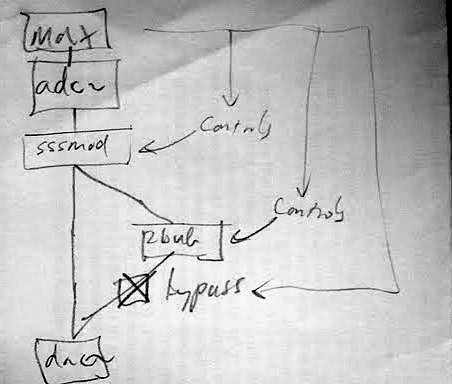
'The diagram is the program' according to Miller Puckette, creator of Pd and (originally) Max. But sometimes you have to draw the diagram too… :)